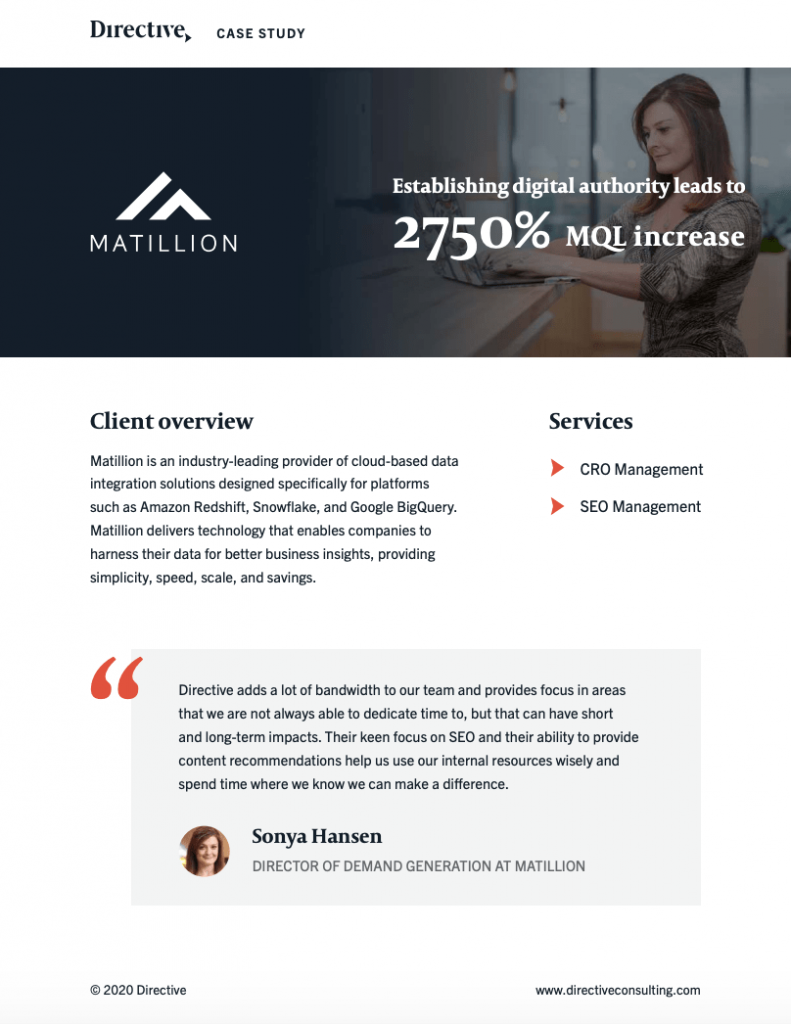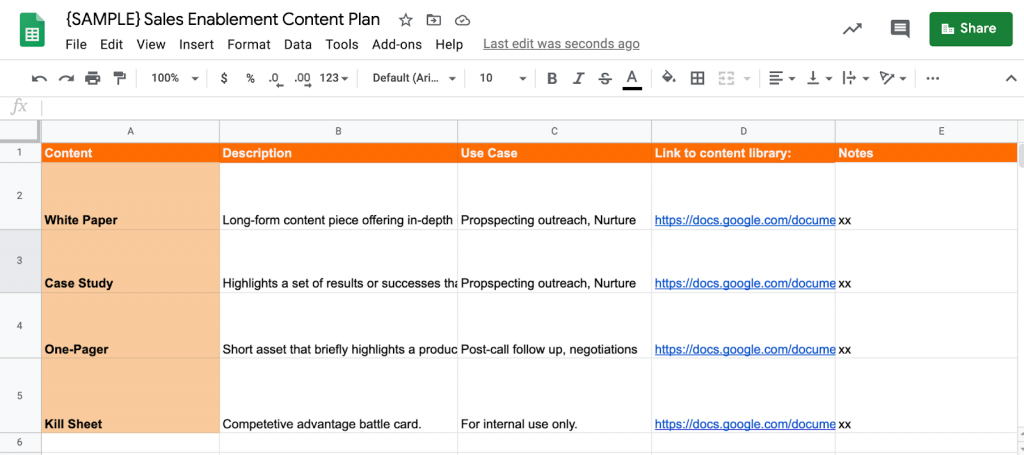Many businesses leverage content marketing as a powerful tool for generating leads, growing organic traffic, and educating audiences.
It’s common to see much of the focus around content revolve around how it can help grow your business externally. However, that same content can be equally as helpful for your internal teams, especially sales.
This falls under the umbrella of sales enablement. And believe it or not, it’s more than just a buzzword.
Sales enablement is the process of providing your sales team with all the resources they need to close more deals and hit revenue targets.
Where, exactly, does content fit into all of this?
Well, I’m here to cover exactly that. Plus, I’ll share five easy-to-follow tips for creating content that’s useful and actually makes an impact on sales performance.
Let’s get started.
Content’s Role in the Sales Process
For content to be successful, it must have a clear objective.
Salespeople have limited time and resources. The goal of sales enablement is to arm your internal sales team with the resources to sell more effectively. This means creating content that helps push deals forward so that sales reps can spend more time selling and less time coming up with material on their own.
What does this actually look like?
Well, sales enablement content can take various forms. Anything from training materials to product pricing plans can fall under this category.
The type of content you create will depend on what it’s being used for. During the prospecting and nurture phases of the sales process, a case study or e-book can be helpful in keeping prospects warm and providing immediate value upfront.
For sales conversations that take place during the negotiation phase, a competitive one-pager would likely be more effective at moving that deal forward.
5 Tips for Creating High-Impact Sales Enablement Content
Sales enablement content has to be intentional.
The content itself is going to be different than writing for SEO or lead generation. At the same time, you still need to take into account everything you normally would, such as how you’re going to distribute the content and what type of format it should be in.
Below, we’ve outlined five easy-to-follow tips to kickstart your efforts:
1. Meet with Sales to Understand Pain Points
If the goal is to help sales reps do their jobs better, then achieving alignment between the marketing and sales teams is absolutely critical.
Before you move forward with creating content, sit down with the sales team and get a strong understanding of the biggest pain points they encounter throughout the sales process.
What objections do they face most frequently? What feedback do prospects have when it comes to your product/service?
Asking these questions allows you to identify gaps in the sales process and strategically create content that addresses them.
For example, let’s say you work for a software company that specializes in influencer marketing software.
You find out from speaking with the sales team that prospects frequently have a hard time understanding if your product integrates well with other solutions. With this information, you create a one-pager that outlines all of the software integrations your product is compatible with.
The sales team is now armed with an asset that clearly explains these capabilities to prospects in an easily consumable way.
2. Create Different Content for Different Use Cases
As mentioned earlier, not all content is created equal.
Let’s break this down further. Below, I outline the most common types of sales enablement content and when and why you should use them.
CASE STUDIES
A case study is a piece of content that highlights a set of results or successes that a customer achieved using your product or service.
Potential customers are going to want to take a look at these.
Case studies are powerful tools for showcasing specific product features (or tactics) and how they’re actually being used and applied by other companies.

Case studies provide relevant value to a prospective customer who may be on the fence about your business or needs proof that a similar company succeeded by trusting you.
The key is to create case studies that showcase customers in different industries or who have used your product/service in different ways. Having variety allows sales reps to customize their outreach by using a case study that’s relevant to the prospect company.
For example, a healthcare company would benefit a lot more from reading a case study featuring another healthcare provider than a business that operates in the telecommunications industry.
SALES DECK
A sales deck is a fancy term for a slideshow presentation that’s used to demo your product or service.
By the time a prospect agrees to meeting with a member of your sales team, they’re interested enough to want to learn more about your business and take time out of their busy day.
This presentation is the tipping point that determines whether or not this prospect actually has a chance at becoming a paying customer.
A sales deck will communicate the value of your business in a concise and visually appealing way. The buyer should leave that meeting with a clear understanding of exactly what your company does and how it can help them.
It’s also a good idea to build your sales deck in a way that’s easily customizable.
You want to make the presentation experience feel more personalized and curated for the person on the other end. This can be as simple as swapping out logos for each new presentation or including optional slides that cater to the prospect company’s specific industry.
“KILL SHEETS”
A “kill sheet”, also referred to as a battle card, is a piece of content that outlines your businesses’ competitive advantages.
It’s common to have multiple kill sheets for each one of your top competitors that feature information such as pricing, features, market share, and any other intel that would be helpful during sales conversations.
Sales reps use these as a quick, go-to resource when they’re on calls with prospects. A good kill sheet is concise, up-to-date, and easy to extract information from at a glance.
ONE-PAGERS
A one-pager is a content asset that provides a brief (but strong) overview of a business, strategy, or product feature.
The goal is to provide the prospect with a clear, easy-to-read document that outlines additional information about your business and how your offering can help solve their problems.
Sales reps don’t want to take too much time while on a call explaining the intricacies of your business. Instead, they can follow up with the prospect by sending the one-pager, which provides them with the in-depth details they may be looking for.
WHITE PAPERS
A white paper is a long-form piece of content that usually features original research or data. It’s commonly published in the form of a gated report.
White papers are considered to be “premium” content because they are in-depth and usually take on a persuasive or authoritative tone.

Most commonly, the goal of a white paper is to educate readers, establish credibility for the brand, and generate leads. However, they can also be used as an effective sales enablement tool.
During the sales process, sales reps can use white papers to show off your company’s expertise within your field.
They seal the deal when used during the prospecting or nurture phase, during which prospects may be aware of your business but not yet ready to take a sales call.
PERSONA DOCUMENTATION
Salespeople need to know their audience like the back of their hand.
That’s why persona documentation is crucial. The foundation of sales and marketing alignment is having a mutual understanding of exactly who your target market is and what they care about. This allows both teams to obtain the qualified leads they’re looking for.
Marketers should lean on the sales reps as a resource when building out these personas. After all, these are the people at your company who are speaking to prospects every single day.
Once you understand what these personas look like, formally package them into an asset that both teams have access to. These documents can be used to train new sales and marketing hires in the future.
DEMO VIDEOS
Many people prefer watching videos over reading written content.
As a result, video has proven to be a popular medium for sales and marketing teams.
Although there are numerous routes you can take with video, demo videos can be powerful. A demo video is simply a video that shows prospective buyers how to use your product or leverage your service. A great demo video should be quick, provide fast facts, and be easy to consume.
This way, salespeople can spend their time building relationships and addressing prospect pain points, instead of giving high-level product or strategy demonstrations.
3. Build Out A Sales Enablement Playbook
Having a library full of fantastic sales enablement content is just the first step. It’s equally as important that your sales team knows what to do with all of it.
That’s where a sales enablement playbook can come in handy.
To best equip your sales team with what they need to succeed, build out an asset that outlines the different types of content and when to use it during the sales process.

There’s no “one-size-fits-all” answer that will prove to work in each unique sales scenario. However, you can at least provide recommendations for certain content throughout different stages of the sales process.
4. Harness the Power of Social Proof
Put simply, social proof is the idea that buyers will follow the actions of other like-minded buyers.
Nowadays, most B2B buyers conduct their own research and seek out social proof before they ever even speak to a member of your sales team. This means that incorporating elements of social proof into the sales process is critical to keeping buyers engaged and meeting their expectations.
Social proof can take on many forms such as customer testimonials, third-party reviews, positive social media mentions — the list goes on.
Marketers should look at this as an opportunity to highlight the successes of your happy customers in the sales collateral you create. Think about it: doesn’t a case study feel much more credible and authentic when there’s a customer testimonial tied to it?
Incorporating social proof into your sales enablement content will help you tell your brand’s story in a way that feels more authentic to the buyer on the other side. Plus, a salesperson’s job becomes much easier when a buyer enters the sales process with an already-established positive perception of your brand.
5. Measure the Impact of Your Content
Attributing revenue dollars to content is difficult as it is. When it comes to sales enablement, one of the best ways to measure the impact of your content efforts is to directly seek out feedback from the sales team.
Ask them what’s working, and if prospects are responding positively or negatively to any of the content you’ve created. For content that’s published directly on your website, keep tabs on how many clicks, downloads, and views each piece receives.
For those of you who are a little more data-driven, keep a close eye on the length of the sales cycle as well as lead-to-customer conversion rate. While these metrics aren’t tied solely to content, they still can provide valuable insight into how your overall sales enablement tactics are contributing to bigger company goals.
Conclusion
We spend a lot of time thinking about content creation within the context of the marketing funnel. There’s a heightened level of attention on generating awareness at the top of the funnel and converting leads at the bottom. I challenge you to think of sales enablement as something that happens in the “post-funnel” phase.
A marketer’s job isn’t done when an MQL converts to an SQL. Until the moment that deal closes, there’s plenty that marketing can do to empower sales and push the needle on revenue goals.